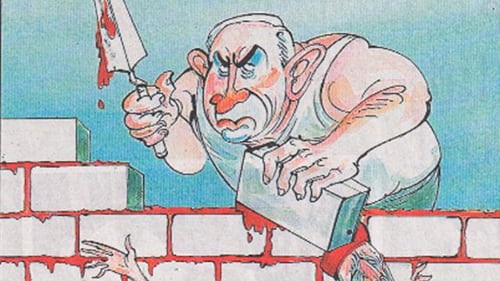Eli Valley’s “17-Point Guide To Anti-Semitism And Its Abuse,” published in these pages, fell short. It really ought to have been an “18-Point Guide To Anti-Semitism And Its Abuse,” with Eli Valley himself starring as the 18th Point.Let me explain.

1. On Holocaust Memorial Day (Jan. 27, 2013), Britain’s Sunday Times newspaper published a cartoon by Gerald Scarfe that caused many Jewish readers to practically choke on their Sunday bagels. The paper was deluged with complaints from readers, and from UK and overseas Jewish groups, before issuing a prompt apology.
2. Eli Valley believes that the complainants were wrong. That is fine. He is welcome to his opinion, but his vilification of those who disagree with him is disgusting: accusing them of “an exploitation of Jewish historical trauma” and an “abuse of excruciatingly painful Jewish memory.” Valley does not state outright that this was all somehow falsely manufactured in order to defend Israel’s polices, but his implication seems clear enough to me and also to many of the anti-Zionists who so enjoyed his polemic.
What then of the cartoon and of the complaints it generated?
3. Gerald Scarfe (best known internationally for his graphics on Pink Floyd’s The Wall) is a cartoonist noted for his bloodiness and this cartoon is not the worst example of that. It depicts Benjamin Netanyahu as a burly builder, cementing a brick wall with body parts and screaming heads protruding from it. He is using blood for cement. It drips from the trowel and oozes between the bricks.
4. Unfortunately, anti-Semites also have a thing about blood. The perverse medieval anti-Semitic association of Jews and blood never went away. Its lineage and imagery persists in the worst of modern Arab and Muslim hate propaganda. Some of this is blatantly anti-Semitic, some of it is anti-Israel and most of it is probably up for debate, but its offensive, visceral power is undeniable. The Scarfe cartoon would comfortably fit in any compendium of such grotesqueries.
5. Nevertheless, Valley denies all of this context, by describing the cartoon simply as “an image critical of Benjamin Netanyahu’s policies in the West Bank.” I have already written that ultimately, the cartoon is anti-Netanyahu, not anti-Jew: but to call it merely “critical” is to blind eye its place within the canon of contemporary overlapping anti-Semitic and anti-Israel hate imagery. It is this gross underselling that facilitates Valley’s vilification of those who saw it differently.
6. The complex reality of how anti-Semitism is actually perceived by its victims. Valley gets halfway there with his mentions of “Jewish historical trauma” and “excruciatingly painful Jewish memory,” before effectively denying the effect of this tragic history upon Jewish perceptions today. My own office, Community Security Trust, has never received as many complaints about a cartoon as it did this time around. Other UK Jewish representative groups got the same reaction. Objectively, analytically, in isolation, the cartoon may not have been anti-Semitic per se, but its blood theme and publication date sent it smashing full pelt into Jewish emotions and sensitivities.
7. The placement and timing. If this were just another hate cartoon in Arab media, then it would have been flagged on a few pro- and anti-Israel websites and that would have pretty much been it. Instead, this was in the Sunday Times and it did not occur during an actual bloody conflict between Israel and its neighbours. For Jewish readers on a Sunday morning, the cartoon came out of the blue, where it was least expected and on Holocaust Memorial Day: not the happiest of coincidences.
8. The UK context. After bruising cartoon controversies with Dave Brown at the Independent newspaper (Ariel Sharon biting the heads off babies) and Steve Bell at the Guardian newspaper (Netanyahu using British politicians as glove puppets), British Jews are somewhat fed up discussing anti-Israel cartoons that are “critical,” yet echo with anti-Semitic charges. Furthermore, the cartoon broke as British Jews were trying to comprehend and react to a Member of Parliament, with a large Muslim community, who had used his signing of a Holocaust commemoration book in order to accuse “the Jews” of “atrocities” against Palestinians. Seriously, this Scarfe argument was neither sought, nor welcomed.
9. So, we have a cartoon that is viciously anti-Netanyahu and shocked many British Jews. It was in the vein of other damaging cartoon arguments, and came smack on top of another Israel-Jews-Holocaust memorial controversy. In trying to explain and verbalize their shock, many British Jews made reference, in some way or another, to the Blood Libel. (No surprise, given the amount of blood in the image.) Jewish representative groups accurately stated that the cartoon depicted Netanyahu and that it was typical Scarfe. We did not call Scarfe an anti-Semite. We stated that to us, his cartoon resonated with, or was reminiscent of, anti-Semitic blood imagery and that it arrived on Holocaust Memorial Day. For this, Valley accuses us of deliberately and immorally abusing the history of anti-Semitism, including even the Holocaust. It is a disgraceful slur.
10. Sadly, Valley’s glib assurance that the cartoon “will not lead to anti-Semitism” is also wrong. In Britain, my own organization’s annual anti-Semitic incidents report regularly includes examples of hate crimes where anti-Semites make direct reference to specific media coverage of Israel or Jewish issues, while making anti-Semitic abuse and threats. (For example, see “f***ing Jewish c***s” graphic on p.16 of our 2012 report, pdf here.) More generally, all types of hate crime are influenced by the mood music that pervades whatever the particular issue happens to be, and anti-Semitism is no magical exception to this basic rule of how racism works.
Finally, the next time Eli Valley makes sordid accusations about the abuse of anti-Semitism and Holocaust memory for political point scoring, let him start by looking in the mirror.






